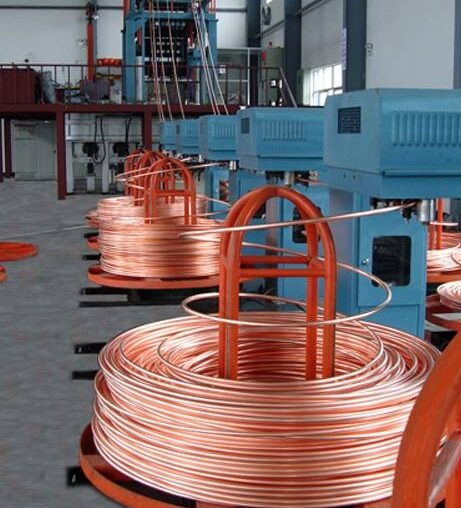Copper Wire Rods play an indispensable role in the world of electrical engineering. Thanks to their superior conductivity, durability, and versatility, they are the backbone of power transmission and electrical systems. Choosing high-quality copper wire rods can significantly impact the performance and longevity of electrical applications, making them a favored choice among engineers and manufacturers.
Introduction to Copper Wire Rods
Copper wire rods are semi-finished copper products used in the manufacturing of wires, cables, transformers, and other electrical components. Processed from high-purity copper, these rods serve as the raw material for drawing fine wires or strands required in a wide array of electrical systems.
Their importance lies in their excellent conductivity. Copper ranks second only to silver as the most conductive metal, making it a preferred choice for efficient electrical transmission. Beyond conductivity, its mechanical properties and ease of fabrication add to its widespread use.
The demand for high-quality copper wire rods has surged, particularly in sectors where precision, durability, and reliability are crucial. From power grids to electronic devices, copper wire rods are the foundation of many modern technologies.
Key Properties of High-Quality Copper Wire Rods
Copper wire rods possess unique properties that make them essential for electrical engineering applications. Here are the key features that define their unmatched performance:
1. Excellent Electrical Conductivity
Copper Wire Rods have an impressive ability to conduct electricity, with only minimal resistance. This ensures efficient power transmission with reduced energy losses.
2. Thermal Conductivity
High-quality copper conducts heat effectively, making it ideal for applications where thermal control is critical, such as transformers and motors.
3. Corrosion Resistance
Copper is naturally resistant to oxidation and corrosion, allowing products made from copper wire rods to perform reliably even in harsh environments.
4. Strength and Ductility
Copper wire rods strike a balance between mechanical strength and ductility, enabling easy fabrication and the ability to bear mechanical stress without breaking.
5. Longevity
When sourced and processed correctly, copper wire rods offer decades of efficient performance, making them a cost-effective investment for long-term applications.
Advantages of Using Copper Wire Rods in Electrical Engineering
Opting for high-quality copper wire rods comes with several advantages that directly impact the performance, reliability, and efficiency of electrical engineering applications. Below are the key benefits:
1. Superior Electrical Efficiency
One of the most significant advantages of copper wire rods is their exceptional conductivity. They provide minimal resistance to electrical flow, translating to reduced energy loss during power transmission. This efficiency is crucial in high-performance electrical systems.
2. Durability in Extreme Conditions
Copper wire rods are built to withstand challenging conditions, including high temperatures, humidity, and corrosive environments. This durability makes them ideal for industrial and outdoor electrical setups.
3. Ease of Fabrication
Due to their ductility and malleability, copper wire rods can easily be drawn into wires or other forms without compromising their structural integrity. This flexibility supports intricate electrical designs and applications with high precision.
4. Cost-Effectiveness Over Time
While high-quality copper wire rods might cost more initially, their longevity, low maintenance requirements, and efficiency provide long-term cost savings.
5. Reduced Energy Loss in Power Grids
Copper’s low electrical resistance ensures minimal energy dissipation, making it the preferred option in power transmission networks where efficiency is paramount.
6. High Sustainability
Copper is a recyclable material, making copper wire rods an environmentally friendly option for electrical engineering projects. Their sustainability aligns with eco-conscious industrial practices.
7. Wide Application Range
From small devices to large-scale infrastructure projects, copper wire rods cater to a variety of applications, thanks to their versatile physical and electrical properties.
Applications of Copper Wire Rods in Electrical Systems
The versatility of copper wire rods allows their usage in a wide range of electrical systems. Below are some key applications where they play an integral role:
1. Power Transmission Lines
Copper wire rods are integral in overhead and underground power cables, ensuring efficient conduction of high-voltage electricity with minimal losses.
2. Transformers
The thermal and electrical conductivity of copper rods makes them ideal for producing windings in transformers, where heat dissipation and reliability are essential.
3. Electrical Motors and Generators
Wires drawn from copper wire rods are commonly used in the winding of motors and generators, which demand superior energy efficiency.
4. Residential and Commercial Wiring
For both residential and commercial projects, high-quality copper cables derived from copper wire rods are the preferred choice due to their safety and reliability.
5. Renewable Energy Systems
Wind turbines and solar panels require durable and conductive materials such as copper wire rods for efficient energy generation and transmission.
6. Electronics Industry
Printed circuit boards (PCBs), connectors, and other components rely on copper wires for smooth and reliable electrical performance.
How to Identify High-Quality Copper Wire Rods
Given the critical role of copper wire rods in electrical engineering, it’s essential to ensure you’re sourcing the highest quality. Here’s what to check for when assessing copper wire rods:
1. Purity of Copper
High-quality copper wire rods are made from nearly pure copper, usually 99.9% or higher. Any impurities can reduce their electrical efficiency and strength.
2. Surface Finish
Ensure rods have a clean, smooth surface with no cracks, scales, or impurities, as defects can compromise their performance.
3. Dimensional Consistency
Quality products maintain uniform dimensions across the length of the rod, ensuring compatibility with electrical applications.
4. Certifications
Verify that the rods meet established industry standards like ASTM or ISO certifications.
5. Supplier’s Reputation
The credibility of copper wire rod suppliers often indicates material quality. Always choose trusted suppliers with a proven track record.
Conclusion
Copper wire rods are an indispensable material in electrical engineering, providing exceptional conductivity, durability, and versatility for a range of applications. Their role in advancing power systems, electronic devices, and renewable energy projects highlights their significance in modern industrial development.
Sourcing high-quality copper wire rods from reliable suppliers ensures long-term performance, safety, and efficiency for your electrical systems. By investing in premium materials, you empower your operations to meet the demands of today’s technology-driven world.
